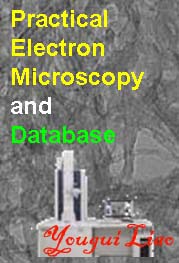
Chapter/Index: Introduction | A | B | C | D | E | F | G | H | I | J | K | L | M | N | O | P | Q | R | S | T | U | V | W | X | Y | Z | Appendix
| Diffuse scattering in electron diffraction can be induced by disordering or less-ordering of some atomic arrangements. Especially, such diffuse scattering can apparently be visible on the background around strong Bragg spots in diffraction patterns of crystals. For instance, two niobium tungsten oxides (Nb7W10O47.5 and Nb4W13O49) consist often of less-ordered arrangements of filled tunnels, causing the diffuse scattering in electron diffraction. Figure 2328a shows the electron diffraction patterns (along [001]) of two crystallites of Nb7W10O47.5 presenting circular diffuse scattering in different degrees, which appears around the main bright reflections of the basic TTB substructure. In Nb4W13O49 as shown in Figure 2328b, the diffuse scattering pattern is cross-shaped due to the presence of long slabs of diamond-linked pentagonal columns. Overall, the origin of the diffuse scatterings is presumably the presence of short-range order in the PC (pentagonal columns) sublattice [1], or an intermediate state of order (or called transition state [2]) between a random arrangement and a long-range ordered structure. In addition, the weak spots indicate TTB superstructures.
Figure 2328a. The electron diffraction patterns (along [001]) of two crystallites of Nb7W10O47.5. Adapted from [3]
Figure 2328b. The electron diffraction patterns (along [001]) of a Nb4W13O49 crystallite. Adapted from [3] The diffuse scatterings in electron diffractions taken from two Nb2WO8 crystallites shown in Figure 2328c also indicate the disorder among the PC (pentagonal columns) distribution within the TTB framework.
Figure 2328c. (a) and (b) Electron diffractions in two Nb2WO8 crystallites, respectively.
Adapted from [4]
Figure 2328d shows a selected area electron diffraction (SAED) pattern of an Bi12.8Co0.2Mo5O34±δ (a = 11.7226(6) Å; b = 5.7959(2) Å; c = 24.6994(11)Å; β = 102.08(1)°, space group P2/c (13)) crystal taken along [010] and [100] zone axes. The weak lines of the diffuse scattering along the c* direction (e.g. marked by the red arrow) indicated the presence of atomic disordering of this crystal structure.
Figure 2328d. Selected area electron diffraction (SAED) pattern of an Bi12.8Co0.2Mo5O34±δ crystal taken along [010] (a) and [100] (b) zone axes. Adapted from [5]
[1] Iijima, S. & Cowley, J. M. (1977). J. Phys. Colloq. 38, 135-144.
|